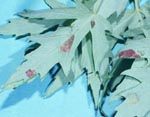Gall Mites of Maple
Vasates spp. and Eriopyhes spp.

Figure 1. Eriophyhes
spp. Mite Gall on Silver
Maple
Description
The galls are usually a brilliant red and may resemble a bladder, spindle, or a dense mass of hairy or bead-like growths called erinea (0.15 mm in diameter). The galls may form on either the upper or lower surfaces of the leaf. Some of the erineyum-type galls may resemble felt patches or when magnified have a texture similar to a beaded surface.
Life History
The maple bladder gall mite is most common on silver maple but also common on red maple. The gall is usually a brilliant red and bladder-shaped. Early spring foliage is most affected particularly those leaves next to the trunk or branch. The maple spindle gall mite occurs most frequently on sugar maple. The red erineum gall mites are common on maples but are also found on Norway maple and boxelder. Gall mites overwinter as adults under the bark where they can withstand severe winter conditions. Early in the spring they move to the unfolding leaves and begin feeding. The mites feed on the underside of the leaves. The leaf rapidly produces a pouch like structure enclosing the mite. The mite continues to feed and develop and then lays eggs within the gall. Adults move to new leaves to produce more galls. Mite activity usually ceases by July. Galls draw attention from homeowners due to their color, but do not warrant control.
Damage
Not considered serious.
Chemical Control
Not warranted